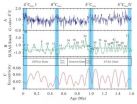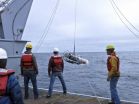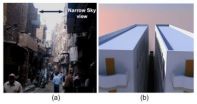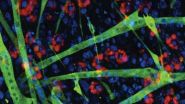(Press-News.org) Quantum superposition is a fundamental and also intriguing property of the quantum world. Because of superposition, a quantum system can be in two different states simultaneously, like a cat that can be both "dead" and "alive" at the same time. However, this anti-intuitive phenomenon cannot be observed directly, because whenever a classical measuring tool touches a quantum system, it immediately collapse into a classical state. On the other hand, quantum superposition is also the core of quantum computer's enormous computational power. A quantum computer can easily break the widely used RSA (Rivest, Shamir and Adleman) security system with Shor's algorithm. But for now, quantum computation still suffers from the decoherence induced by environment. Obviously, the key to manipulate a quantum system is to make it stay coherent as long as possible, to achieve this, one need to isolate the system from its environment. "For ground-breaking experimental methods that enable measuring and manipulation of individual quantum systems", Serge Haroche and David Wineland won the 2012 Nobel Prize in Physics.
This review begins by introducing the interesting property of quantum superposition, explaining its physical meaning, potential applications and main obstacles ahead. Then the author goes on to introduce the work of the two 2012 Nobel Prize Laureates – Serge Haroche and David Wineland. Instead of manipulating a neutral atom or a photon, Wineland and his team focused on controlling a charged atom, the ion, in an electromagnetic well. In order to break the limit of Doppler cooling, a new cooling technique – Side-Band cooling was used to reach extreme low temperature. The well cooled ions made an ideal platform for building optical clock and quantum computer. Since 2001, Wineland and his team had realized several optical clocks with very high precision. They had also realized basic quantum logic gate in ion trap and demonstrated the scalability of ion system, proving their system is promising for practical quantum computation. This article covers the above topics and gives detailed review.
In the fourth section, the author introduces the work of Haroche and his collaborators. Haroche et al managed to build a high-Q microwave cavity with superconducting materials and cooled it down to superconducting phase. According to Meissner effect, photons in the cavity cannot penetrate the superconducting mirror and will be trapped inside, thus isolate the photons from its environment. Since the cavity has extremely high-Q, the Rydberg atoms inside the cavity are strongly correlated to the photon field, which makes a perfect platform for testing the fundamental principles of quantum mechanics. With the aid of quantum non-demolition measurement, quantum processes can be observed without destroying the state. Using this platform, Haroche et al had directly observed decoherence, quantum jump and several other quantum information processes.
Finally, the review introduces recent developments and further applications of quantum manipulation, and then ends with a discussion of the relationship between quantum and classical world. With advanced quantum manipulation techniques, people are able to investigate fundamental quantum mechanics. In return, a better understanding of quantum mechanics makes it possible to develop new technologies that will change our classical world.
INFORMATION:
Publication:
A new epoch of quantum manipulation. Yongjian Han, Zhen Wang, and Guang-Can Guo
Natl Sci Rev (March 2014) 1 (1): 91-100 DOI:10.1093/nsr/nwt024
[http://nsr.oxfordjournals.org/content/1/1/91.abstract]
Quantum manipulation: Filling the gap between quantum and classical world
2014-04-14
ELSE PRESS RELEASES FROM THIS DATE:
New Commission study identifies Europe's top ICT hubs
2014-04-14
Wondering what makes an ICT hotspot? Take a look at Munich, London, Paris or smaller cities such as Darmstadt identified in a new EU Atlas of ICT hotspots. This atlas shows where digital technologies thrive and examines the factors contributing to this success.
Most of Europe's ICT activity takes place in 34 regions across 12 countries (listed in the Annex). Key ingredients to success included access to top Universities and research centres and funding opportunities such as venture capital.
European Commission Vice-President @NeelieKroesEU said: "This is proof that ...
Climate change: The role of oceanic carbon reservoir over glacial cycles
2014-04-14
Glacial cycles at 104-yr time scale have been the focus of Quaternary paleoclimatology over the last century. In recent years with the emergence of continuous high-resolution records (ice cores, deep-sea sediments etc.) from the longer geological past, increasing evidence underscores the significance of long- duration processes at the time scale of 105-yr or more. WANG Pinxian and colleagues from the State Key Laboratory of Marine Geology, Tongji University, reviewed long-term variations in the oceanic carbon reservoir and indicated their crucial role in major climate regime ...
Genetically modified tobacco plants as an alternative for producing bioethanol
2014-04-14
Tobacco, a high-density crop which is mown several times throughout its cycle, can produce as much as 160 tonnes of fresh matter per hectare and become a source of biomass suitable for producing bioethanol. As Jon Veramendi, head of the plant Agrobiotechnology research group, explained, "tobacco plants as a source of biomass for producing bioethanol could be an alternative to traditional tobacco growing which is in decline in the USA and in Europe because it cannot compete with emerging countries like China".
In the course of the research, which has been echoed by the ...
Puget Sound's rich waters supplied by deep, turbulent canyon
2014-04-14
The headwaters for Puget Sound's famously rich waters lie far below the surface, in a submarine canyon that draws nutrient-rich water up from the deep ocean. New measurements may explain how the Pacific Northwest's inland waters are able to support so many shellfish, salmon runs and even the occasional pod of whales.
University of Washington oceanographers made the first detailed measurements at the headwater's source, a submarine canyon offshore from the strait that separates the U.S. and Canada. Observations show water surging up through the canyon and mixing at surprisingly ...
Study links domestic abuse to mental health problems in new mothers
2014-04-14
A new study shows that domestic abuse is closely linked to postpartum mental health problems, including depression and post-traumatic stress disorder (PTSD), in mothers. The research also found that specific types of abuse are associated with specific mental health problems. The work was done by researchers at North Carolina State University, Simon Fraser University and the University of British Columbia.
"We wanted to see whether and how intimate partner abuse – physical, psychological and sexual – influenced postpartum mental health in women, including problems such ...
Neanderthals and Cro-magnons did not coincide on the Iberian Peninsula
2014-04-14
This news release is available in Spanish. Until now, the carbon 14 technique, a radioactive isotope which gradually disappears with the passing of time, has been used to date prehistoric remains. When about 40,000 years, in other words approximately the period corresponding to the arrival of the first humans in Europe, have elapsed, the portion that remains is so small that it can become easily contaminated and cause the dates to appear more recent. It was from 2005 onwards that a new technique began to be used; it is the one used to purify the collagen in DNA tests. ...
Let the sun shine in: Redirecting sunlight to urban alleyways
2014-04-14
WASHINGTON, April 14—In dense, urban centers around the world, many people live and work in dim and narrow streets surrounded by tall buildings that block sunlight. And as the global population continues to rise and buildings are jammed closer together, the darkness will only spread.
To alleviate the problem, Egyptian researchers have developed a corrugated, translucent panel that redirects sunlight onto narrow streets and alleyways. The panel is mounted on rooftops and hung over the edge at an angle, where it spreads sunlight onto the street below. The researchers describe ...
Wolves at the door: Study finds recent wolf-dog hybridization in Caucasus region
2014-04-14
Dog owners in the Caucasus Mountains of Georgia might want to consider penning up their dogs more often: hybridization of wolves with shepherd dogs might be more common, and more recent, than previously thought, according to a recently published study in the Journal of Heredity (DOI: 10.1093/jhered/esu014).
Dr. Natia Kopaliani, Dr. David Tarkhnishvili, and colleagues from the Institute of Ecology at Ilia State University in Georgia and from the Tbilisi Zoo in Georgia used a range of genetic techniques to extract and examine DNA taken from wolf and dog fur samples as well ...
Regenerating muscle in Duchenne muscular dystrophy: Age matters
2014-04-14
LA JOLLA, Calif., April 11, 2014 — A team of scientists led by Pier Lorenzo Puri, M.D., associate professor at Sanford-Burnham Medical Research Institute (Sanford-Burnham), in collaboration with Fondazione Santa Lucia in Rome, Italy, have published details of how a class of drugs called "HDACis" drive muscle-cell regeneration in the early stages of dystrophic muscles, but fail to work in late stages. The findings are key to furthering clinical development of HDACis for Duchenne muscular dystrophy (DMD), an incurable muscle-wasting disease.
A symphony to rebuild muscle
The ...
New 'tunable' semiconductors will allow better detectors, solar cells
2014-04-14
One of the great problems in physics is the detection of electromagnetic radiation – that is, light – which lies outside the small range of wavelengths that the human eye can see. Think X-rays, for example, or radio waves.
Now, researchers have discovered a way to use existing semiconductors to detect a far wider range of light than is now possible, well into the infrared range. The team hopes to use the technology in detectors, obviously, but also in improved solar cells that could absorb infrared light as well as the sun's visible rays.
"This technology will also ...






